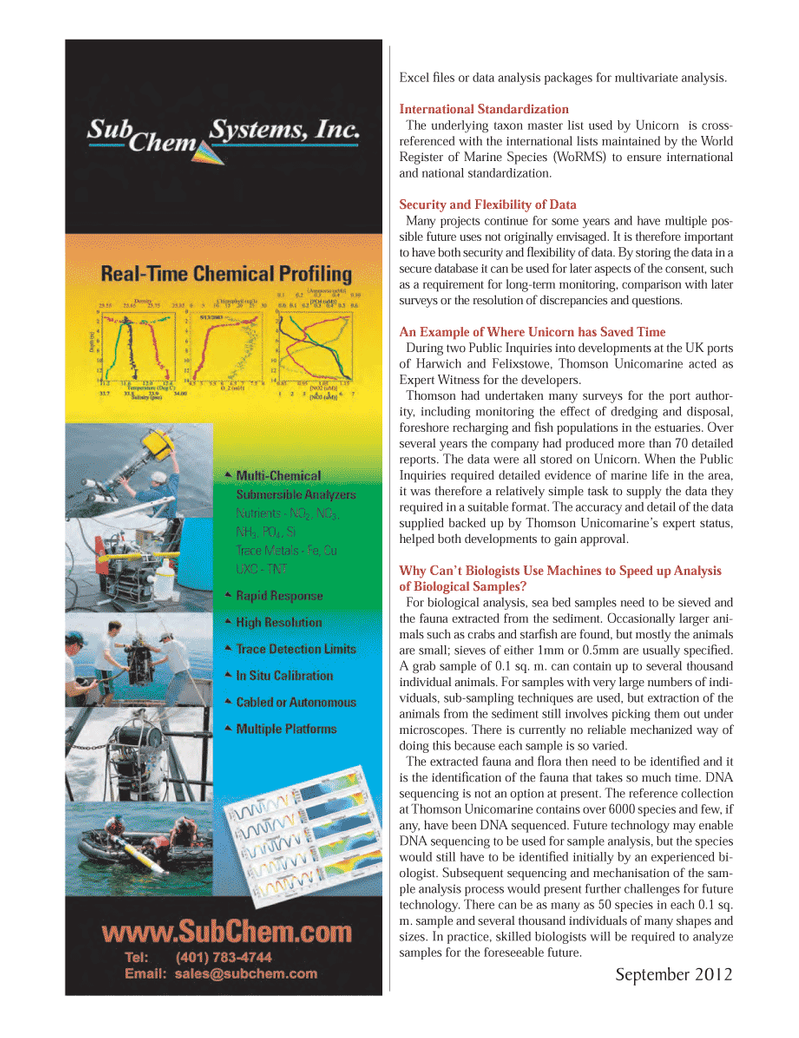
Page 28: of Marine Technology Magazine (September 2012)
Subsea Defense: Protecting Port & Subsea
Read this page in Pdf, Flash or Html5 edition of September 2012 Marine Technology Magazine
Excel Þ les or data analysis packages for multivariate analysis. International Standardization The underlying taxon master list used by Unicorn is cross-referenced with the international lists maintained by the World Register of Marine Species (WoRMS) to ensure international and national standardization.Security and Flexibility of DataMany projects continue for some years and have multiple pos- sible future uses not originally envisaged. It is therefore important to have both security and ß exibility of data. By storing the data in a secure database it can be used for later aspects of the consent, such as a requirement for long-term monitoring, comparison with later surveys or the resolution of discrepancies and questions. An Example of Where Unicorn has Saved Time During two Public Inquiries into developments at the UK ports of Harwich and Felixstowe, Thomson Unicomarine acted as Expert Witness for the developers. Thomson had undertaken many surveys for the port author- ity, including monitoring the effect of dredging and disposal, foreshore recharging and Þ sh populations in the estuaries. Over several years the company had produced more than 70 detailed reports. The data were all stored on Unicorn. When the Public Inquiries required detailed evidence of marine life in the area, it was therefore a relatively simple task to supply the data they required in a suitable format. The accuracy and detail of the data supplied backed up by Thomson UnicomarineÕs expert status, helped both developments to gain approval. Why Can?t Biologists Use Machines to Speed up Analysis of Biological Samples?For biological analysis, sea bed samples need to be sieved and the fauna extracted from the sediment. Occasionally larger ani- mals such as crabs and starÞ sh are found, but mostly the animals are small; sieves of either 1mm or 0.5mm are usually speciÞ ed. A grab sample of 0.1 sq. m. can contain up to several thousand individual animals. For samples with very large numbers of indi- viduals, sub-sampling techniques are used, but extraction of the animals from the sediment still involves picking them out under microscopes. There is currently no reliable mechanized way of doing this because each sample is so varied. The extracted fauna and ß ora then need to be identiÞ ed and it is the identiÞ cation of the fauna that takes so much time. DNA sequencing is not an option at present. The reference collection at Thomson Unicomarine contains over 6000 species and few, if any, have been DNA sequenced. Future technology may enable DNA sequencing to be used for sample analysis, but the species would still have to be identiÞ ed initially by an experienced bi- ologist. Subsequent sequencing and mechanisation of the sam-ple analysis process would present further challenges for future technology. There can be as many as 50 species in each 0.1 sq. m. sample and several thousand individuals of many shapes and sizes. In practice, skilled biologists will be required to analyze samples for the foreseeable future.September 2012MTR #7 (18-33).indd 28MTR #7 (18-33).indd 289/10/2012 9:31:23 AM9/10/2012 9:31:23 AM

 27
27

 29
29
